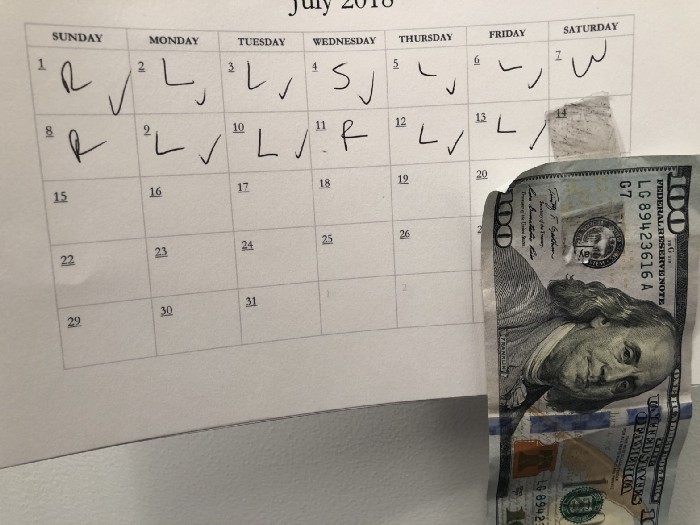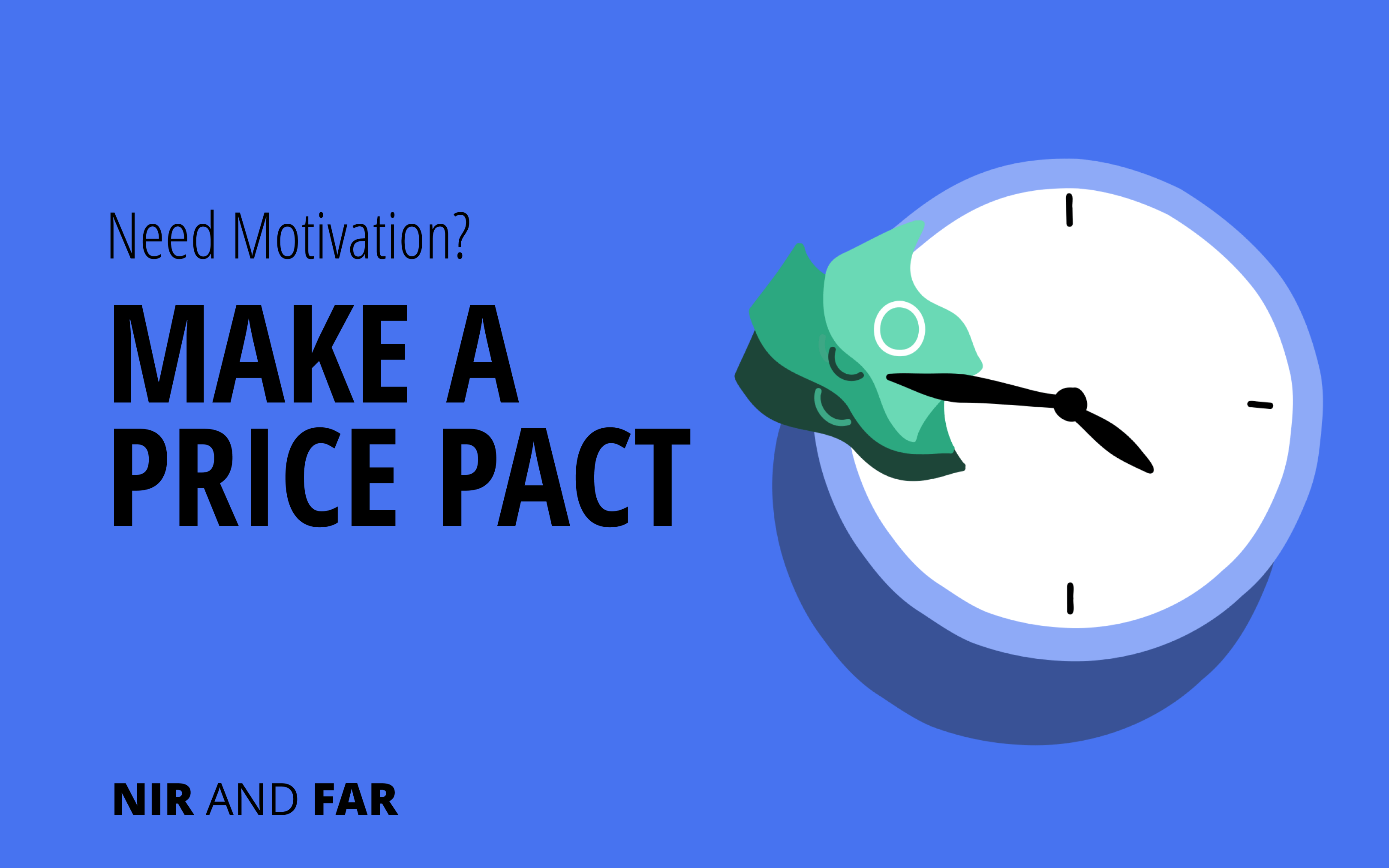This highly effective technique harnesses our distaste for loss to help you reach your goals
Probably the only research paper I’ll ever call “delicious” is one called, “A Tale of Two Pizzas.”
In the study, researchers offered one group of people plain pizzas, plus the option to add ingredients for an additional charge. To a second group, they offered topping-loaded pizzas, with the chance to remove ingredients and pay less. Same thing, right?
Of course, not.
In yet another example of why people are weird, the study found that the second group ended up spending more money on their pies.
Why?
People are more bothered by the idea of losing something they already have than by getting something they don’t.
The principle is at play in one of my favorite goal-achievement tools: price pacts.
The power of price pacts
Pacts are a highly effective type of precommitment for changing behavior. A precommitment is a pledge that removes a future choice to overcome unwanted impulses.
A price pact, for instance, involves putting money on the line to encourage us to do what we say we will. If you stick to your intended behavior, you keep the cash; if not, you forfeit the funds you already have.
It sounds harsh, but the results are stunning.
A study published in the New England Journal of Medicine illustrated the power of price pacts by examining three groups of smokers who were trying to quit.

The first group was offered educational information and traditional methods, such as free nicotine patches, to encourage smoking cessation. After six months, 6 percent of people in the control group had stopped smoking.
The second group, called the “reward group,’’ was offered $800 if they had stopped smoking after six months. 17 percent of them were successful.
The third group provided the most interesting results. Participants in this group, called the “deposit group,” were required to deposit $150 of their own money with a pledge to be smoke-free after six months.
If—and only if—they reached their goal, they would receive the $150 deposit back. In addition to recouping their cash, the successful deposit group participants would also receive a $650 bonus prize from their employer.
The results? Of those who accepted the deposit challenge, an astounding 52 percent met their goal!
One would imagine that a greater reward ought to lead to greater motivation to succeed, so why would winning the $800 reward be less effective than winning the $650 reward plus the $150 deposit?
One of the study’s authors wrote, “People are typically more motivated to avoid losses than to seek gains”: the pain of losing outweighs the pleasure of winning.
As in the pizza study, the fear of loss led to some unexpected behavior changes.
How to use losing to win
We can harness the power of this cognitive quirk in other ways.
A few years ago, I was frustrated at the number of excuses I was making for not exercising regularly.
At the time, going to the gym couldn’t have been easier: the fully equipped facility was located in my apartment complex and was free for residents like me, so I couldn’t blame my no-shows on traffic or membership dues. Yet I somehow found reasons to skip my workouts.
I decided to make a price pact with myself. After making time in my schedule, I taped a crisp $100 bill to the calendar on my wall, next to the date of my upcoming workout. I then bought a 99-cent lighter and placed it nearby.
Every day, I had a choice: either burn the calories at the gym or burn the $100 bill at home.

I know what you’re thinking, “That’s too extreme! You can’t burn money like that!” That’s exactly my point.
I’ve used this “burn or burn” technique for over three years and have gained twelve pounds of muscle, without ever burning the hundred dollars.
A price pact binds us to action by attaching a price to distraction.
The exact dollar amount doesn’t matter so long its loss is enough to hurt. And the pact needn’t be limited to smoking cessation, weight loss, or fitness goals.
In fact, I found it helpful for achieving my professional ambitions as well.
After spending nearly five years conducting research on my book, Indistractable, I knew it was finally time to start putting words to page. I nevertheless found it difficult to get down to writing each day and instead found myself doing even more research. Even worse, I always found myself a few clicks away from mind-consuming media that was entirely irrelevant to my writing goals.
Eventually, I’d had enough with my false starts, half-finished chapters, and incomplete outlines. I decided to put some skin in the game and enter a price pact to hold myself accountable.
I asked my friend Mark to be my accountability partner: if I didn’t finish a first draft of the book by a set date, I had to pay him $10,000.
The thought of forfeiting the money made me sick to my stomach—gone would be the vacation budget I’d set aside for my fortieth birthday; gone would be the fund reserved for my new adjustable desk; most devastatingly, gone would be my book—a goal I so desperately wanted to achieve.
A price pact is effective because it transports the pain of losing from a point in the distant future to the here and now. For me, it worked like a charm, because knowing that I had so much on the line kicked me into high gear
I committed to a minimum of two hours of distraction-free writing time six days per week, added it to my weekly schedule, and got down to work each day.
In the end, I was able to keep my money, and also publish my book.
The pitfalls of price pacts
Pitfall #1: Price pacts aren’t good at changing behaviors with external triggers you can’t escape.
Some behaviors aren’t suitable for changing with a price pact. These include cases in which you can’t remove the external trigger associated with the behavior.
For example, nail-biting is a devilishly hard habit to break because biters are constantly tempted whenever they become aware of their hands. Such body-focused repetitive behaviors are not good candidates for price pacts.
Similarly, attempting to finish a big project that requires intense focus while working next to a colleague who wants to continuously show you the latest photos of their “super cute” puppy is unreasonable.
Price pacts work only when you can tune out or turn off external triggers.
Pitfall #2: Price pacts should only be used for short tasks.
Implementing price pacts like my “burn or burn” technique work well because they require short bursts of motivation—a quick trip to the gym, two hours of focused writing time, or “surfing the urge” of a cigarette craving, for example.
If we are bound by a pact for too long, we begin to associate it with punishment, which can spawn counterproductive effects, such as resentment toward the task or goal.
Pitfall #3: Entering a price pact is scary.
Despite knowing how effective they are, most people cringe at the idea of making a price pact in their own lives—I sure did at first! I struggled with committing to my “burn or burn” regimen because I knew it meant I would have to do the uncomfortable work of hitting the gym.
Similarly, shaking Mark’s hand and pledging to finish my manuscript made me sweat.
Only later did I realize how illogical it was to resist a goal-setting technique that makes success so much more likely.
Expect some trepidation when entering into a price pact, but do it anyway.
Pitfall #4: Price pacts aren’t for people who beat themselves up.
Despite being one of the most successful smoking cessation studies ever conducted, some 48 percent of the participants in the deposit group did not achieve their goal.
Behavior change is hard, and some people will fail. Any program for long-term behavior modification must accommodate those of us who, for one reason or another, don’t stick with it.
It’s critical to know how to bounce back from failure—responding to setbacks with self-compassion instead of self-criticism is the way to get back on track.
While trying a price pact, make sure you are able to be kind to yourself and understand that you can always adjust the program to give it another go.
None of the four pitfalls negate the benefits of making a price pact. Rather, they are preconditions to make sure we use the right tool for the job. When used in the right way, price pacts are a highly effective way to stay focused on a difficult task by assigning a cost to distraction.
Nir’s Note: A previous version of this article misidentified the behavioral economics term, “loss aversion.” Thank you to Daniel Reeves for pointing this out.
Related Articles
- Schedule Maker: a Google Sheet to Plan Your Week
- Habit Tracker Template in Google Sheets
- The Ultimate Core Values List: Your Guide to Personal Growth
- Timeboxing: Why It Works and How to Get Started in 2024
- An Illustrated Guide to the 4 Types of Liars
- Hyperbolic Discounting: Why You Make Terrible Life Choices
- Happiness Hack: This One Ritual Made Me Much Happier

